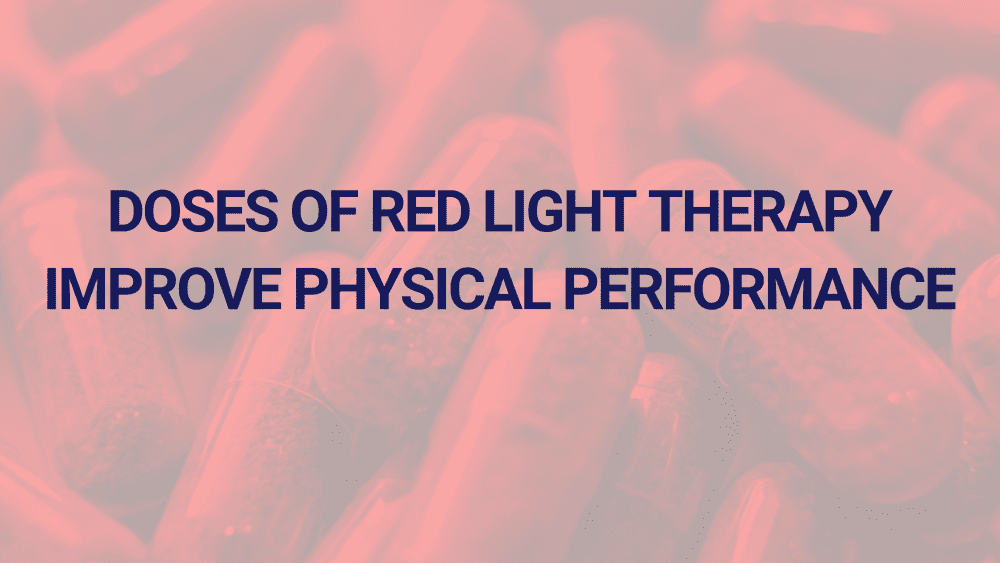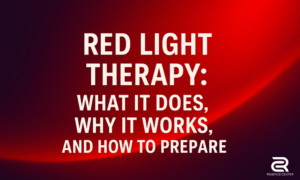Yes, although those doses don’t come from pills; the doses we are talking about are coming from the sun, and in particular from the red and near-infrared spectrums of sunlight.
According to Ari Whitten of The Energy Blueprint[1], “we absorb red and near-infrared light all the time, of course—it’s a mostly invisible part of the light spectrum. But the sun doesn’t deliver the right wavelengths in nanometers of light or the intensity necessary for therapeutic results. [1]
There’s a large base of clinical evidence showing red light therapy, amongst other light frequencies of the light spectrum, improves physical performance and a whole lot more.
That’s the primary reason so many elites, and professional athletes, world-class trainers, and fitness experts are incorporating red light therapy or what’s called Photobiomodulation or “PBM Therapy” into their workout routine to recover from workout stress, as well as their life routine to recover from the stress of life.
Whether you’re an elite athlete or a weekend warrior, longer, stronger, or more frequent workouts on top of life stresses are the status quo. In particular, the overexertion many driven, high-achiever types experience (one of most influential but least talked about contributors to fatigue and pain) can translate into longer recovery periods; and more muscle soreness, fatigue, and potential inflammation and pain, once you leave the gym.
Muscle soreness and joint pain can then prevent you from working out or lead to injuries if you try to push too hard on a weak energetic foundation.
Fortunately, natural and red-light therapy, as part of a proactive recovery plan, where you build in the advanced performance recovery solutions like those at Regenus Center into the process of optimizing your lifestyle, doesn’t just improve physical performance; it improves your human performance (all capacities) by default.
And it does that by recharging and restoring the body’s ability to produce energy, which is vital to healing and preventing the onset of muscle soreness and fatigue after workouts and work stress of any kind that requires exertion.
Here’s a simple explanation: red light therapy delivers safe, concentrated wavelengths of natural light to your skin. These red and near-infrared wavelengths stimulate your cells and reduce oxidative stress, so your body is able to make more usable energy to power itself. This increases function speeds healing, and lowers inflammation & pain, as demonstrated in numerous peer-reviewed studies.
Natural red and near-infrared light helps promote antioxidants, which play a central role in reducing the oxidative stress associated with muscle fatigue. Antioxidants also increase the production of heat proteins—special proteins that help protect cells from stress and early cell death. [2, 3]
Studies have also identified an increase in circulation following light therapy, indicating tissues are receiving more oxygen and other nutrients important for healing—while also ridding themselves of toxic byproducts. [4]
Everyone gets tired and exhausted from time to time. But mounting exhaustion that is not resolved following workouts eventually disrupts your daily life if it builds up far enough. You know you’re there if that feeling of poor recovery doesn’t get better after a good night’s sleep or two. It has its own medical term; it’s called fatigue and you don’t want to build fatigue. You want to build your body– its energy, health, and performance and in that order.
Red light therapy is clinically proven to speed and enhance energy production, muscle recovery, and growth, among countless other functions. This is why so many fully-engaged people, athletes, and trainers love red light therapy more and more ahead of intense training periods, not just post-workout. It delivers better performance, less soreness afterward, and faster recovery so you can get back at it sooner, with less pain and fewer injuries.
Click below to read this research paper on how pbmt therapy improves performance and accelerates recovery for rugby players.
Call 862-295-1620 to Book Your Appointment or Click Here To Book Online
References:
[1] https://www.theenergyblueprint.com/how-often-should-you-do-red-light-therapy/
[2] Avni D, Levkovitz S, Maltz L, Oron U. Protection of skeletal muscles from ischemic injury: low-level laser therapy increases antioxidant activity. Photomed Laser Surg. 2005;23:273–277.
[3] Rizzi CF, Mauriz JL, Freitas Correa DS, et al. Effects of low-level laser therapy (LLLT) on the nuclear factor (NF)-kappaB signaling pathway in traumatized muscle. Lasers Surg Med. 2006;38:704–713.
[4] Tullberg M, Alstergren PJ, Ernberg MM. Effects of low-power laser exposure on masseter muscle pain and microcirculation. Pain. 2003;105:89–96.
General Disclaimer: These services are not intended to diagnose, treat, cure or prevent any disease. This Website offers health and fitness advice. This advice is designed for educational purposes only and is not intended to replace the advice, treatment, or diagnosis of a healthcare professional. Always consult your physician before beginning any therapy program. You agree that you assume all responsibility when choosing to act on any of the health or fitness advice contained on this Website. We reserve the right to amend this policy at any time without any prior notice to you.





